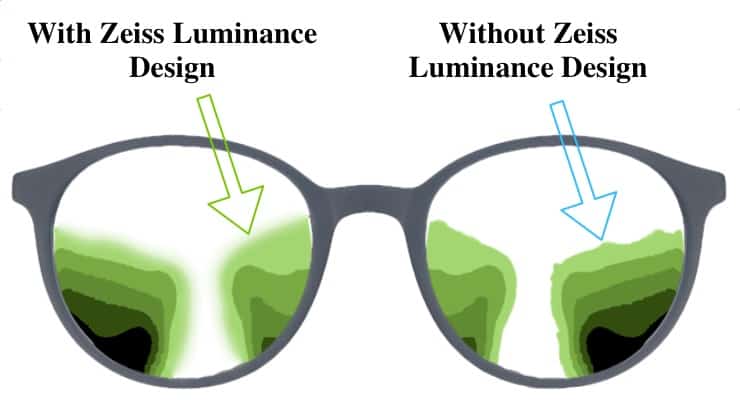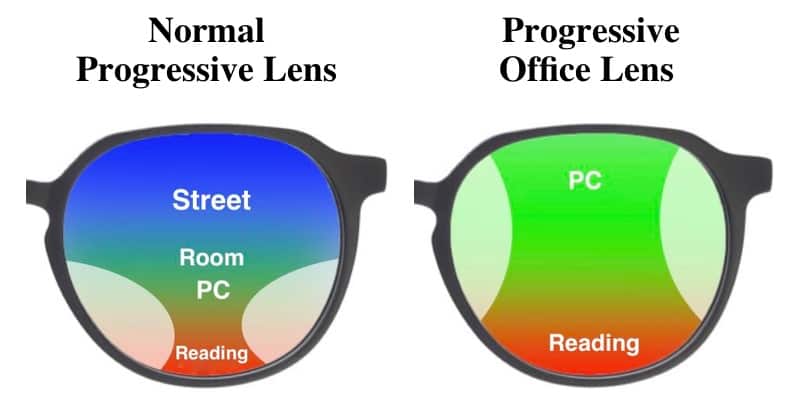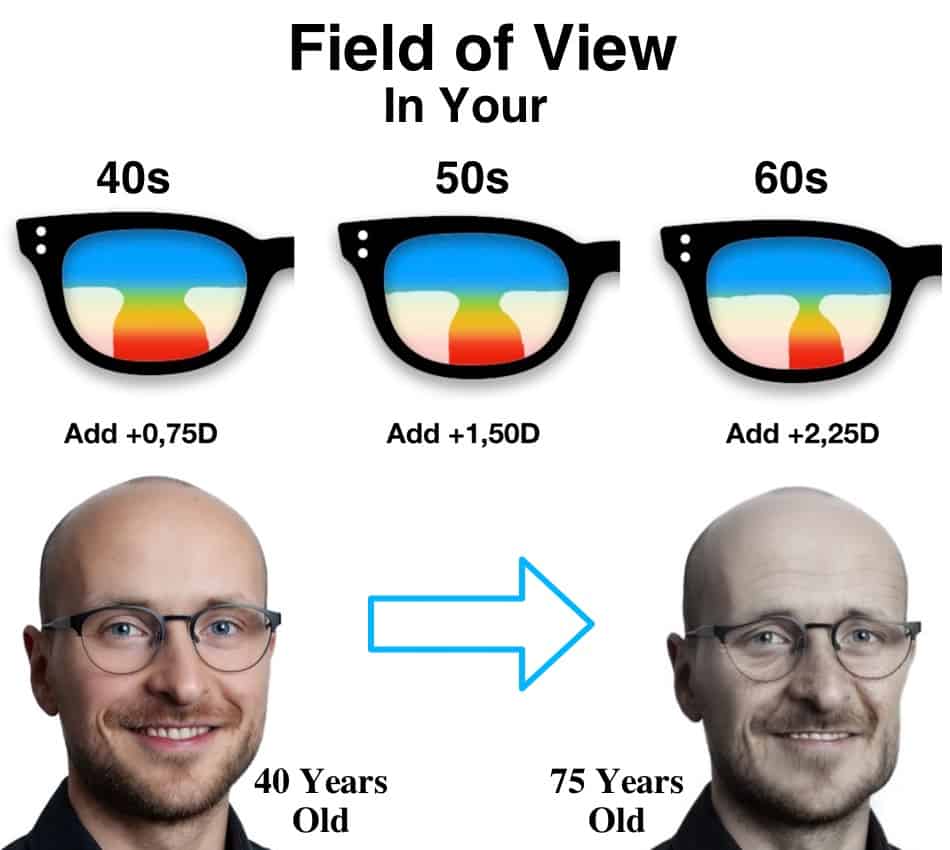Here in this article, you will find the differences in the Zeiss progressive lens types and what options you can choose to get the best out of those premium progressive lenses.
In this table below, you can see the different options that come specifically to the lens types with Carl Zeiss progressive lenses. Those options will be explained in more detail as you read on. In the columns, you find a comparison of the Zeiss progressive lens types. The rows show you the features that come with the lenses.
| Zeiss Pure | Zeiss Plus | Zeiss Superb | Zeiss Individual 2 | |
| Progressive lens design is optimized for your eyes | Progressive lens design is optimized for your eyes and + frame type | Progressive lens design is optimized for your eyes and + frame type + your face | Progressive lens design is optimized for your eyes and + frame type + your face + your lifestyle | |
| IndividualFitTM | ✓ | |||
| Luminance Design® | ✓ | |||
| FaceFitTM | ✓ | ✓ | ||
| Adaptation ControlTM | ✓ | ✓ | ✓ | |
| FrameFit+® | ✓ | ✓ | ✓ | |
| Digital Inside® | ✓ | ✓ | ✓ | ✓ |
| Precision | ✓ | ✓ | ✓ | ✓ |
Zeiss Individual 2
The Zeiss Individual 2 is the most optimized progressive lens you can get. IndividualFitTM will give you three different options to design the clear zones in your new progressives. Depending on your lifestyle you need different zones more or less in your progressive lens. You can choose from:
- Balanced
- Intermediate
- Near
When choosing “Near” in the Zeiss Individual 2 you do not have to look down as much to get into the reading zone in close range. This is very comfortable if you are using digital devices (you tend to hold them closer to you compared to a book) because the transition as you want to switch from far to near will be shorter compared to the “intermediate” version of the Individual 2. This is perfect for you if your main focus is in 30-60cm on the following activities and you prefer to leave your progressive glasses on:
- Reading
- Browsing the web on your Tablet
- Threading a needle
When choosing the “Intermediate” option for the Individual 2 the distance for 60-90cm will get a bigger zone in the lens design. The recommendation here for the minimum height you need from the lower part of the frame is just two millimeters more than the near version but 2mm so close in front of your eyes can make a big difference. This option in the Zeiss individual 2 is recommended for people with constantly switching distances. Those are the following example activities:
- driving your car (you will switch from dashboard to the street in the distance)
- Using a Laptop during a presentation
- Sports
The nice thing with this option is you get up to 28% more clear field of view in the mid-distance with the intermediate compared to the balanced lens design option. If you choose the near version you can get up to 60% more field of view for close-range reading. Sounds great right? But what really stands out here Zeiss is able to do this without compromising your field of view in the distance. That definitely differentiates the Individual 2 from other progressive lenses.
Because with other lens designs you notice more blurriness in your upper periphery as you perform eye movements. In a nutshell, mid distances are not created equal, and just because two lens designs promise you a bigger transition zone that does not mean overall performance needs to be the same in progressive lens designs.
Depending on the needed power of your reading zone I might recommend getting a separate pair of reading glasses or computer progressives anyway. Because as good as the lenses can be in this near or intermediate distances you can just use them as you lower your look into the lower half of the lens. But if you use a desktop PC screen all the time that sits on the level of your head you can not use those zone with your natural posture. And if you need to raise your chin all the time you would be better off with a separate pair of computer progressives.

With the Luminance Design technology, Zeiss further developed a way to smoothen the transitions from the clear zones into the blurry periphery in the lower half of the lenses. Zeiss achieved this by using an entire beam of light that passes your pupil for the progressive lens calculations instead of just one ray. This gives you the ability to have the best possible contrasts with different lighting in your environment. 94% were satisfied with the results in everyday tasks.
Those two Lens Technologies are exclusively available with the Individual 2. As we discuss the other Zeiss progressive lenses and their features the Individual 2 has them also considered into the calculations. The same is true for other progressive lens designs as we move down and I mention some Tech the lower-priced variants have are already built into the high-end variants. The table above gives you a comparison of which Zeiss technologies are ordered with which progressive lenses.
Zeiss Superb
This progressive lens design uses special calculations to give you the same clear width of view in both eyes simultaneously. That might sound unfamiliar to you but the blurry zones in your progressive lenses are dependent on your prescription which is seldom the same for both eyes and how the glasses sit in your face.
So you can expect the blurry zones to change as soon as the glasses are more or less inclined and the angles and distances change to your eyes. When both eyes have clear zones the width of the field of views gets maximized. It is always crucial to get the best consultation, centration, and refraction possible. So go to an optician who takes his time to get the maximum out of this lens feature.

Zeiss Plus
One important point of how well and fast you can adjust to your progressive glasses is if you need to adjust to them and if so how much. Over the years your body learned a few movement patterns to directly have the reading zones in front of your eyes as you want to read. With adaption control built into this lens and the lens models above a few parameters are being considered when your new progressives are ordered.
- What type of progressive lens you wear now
- What is the length of the progressive lens (how much do you need to look down to be able to read)
- Where are you looking through the lenses in your new frame
- How much lens power do you need in your reading zone
With those parameters set when placing your order, Zeiss ensures your new progressive lenses provide you with a lens design that does not mess with your leaned movement patterns. If you want just new lenses and you do not need to adjust to your new progressives as much this is the feature to go for you. But a word of caution here. This progressive lens feature calculates the optimal new lens for you.
So it gets optimized as much as it can. That means if your reading power is significantly higher in your new progressive lenses compared to your old ones like +1,50 to now +2,25 I expect you must adjust to the new lens. The reason is clear zones will get smaller in the reading zones the more reading power you need. So keep that in mind.
Another great Technology that comes into play the Zeiss Plus and above is the Framefit+ option. What you get here is the optimization of the length of your Progressive lenses. This determines how much you need to look down to be able to read. In a longer progressive lens design, you need to lower your eyes more and you get a bigger zone for the mid-distance.
If you order a shorter lens the intermediate distance will get smaller and you do not need to lower your eyes as much. Framefit+ does this for you and is dependent on how the new frame sits in your face. A nice addition to that is that the blurry periphery gets distributed over the lens surface so it is as much out of your way as possible. This ensures the most comfortable experience with different heights of the frames you choose.
Zeiss Pure
The Pure is the baseline model of Zeiss´s progressive lens designs. It already comes with the digital inside technology. This means the lenses are made with taking your digital devices into account because you tend to hold them closer to your eyes compared to printed media. In a lot of manufacturers, lower-priced progressive lenses are just the old type of lenses that were developed in a time were smartphones and tablets did not play such an important role to us.
When you hold things a little bit closer to your eyes your eyeballs are positioned differently and therefore you are looking through different zones of your lenses. This is what digital inside means. It is a newer design that takes the needed distances into consideration that older progressive lens designs just not do.
One of the biggest difference a feature can make in progressive lenses is the Zeiss precision feature. As you can see in the video above you always get a smaller zone in the lower half of the lens for reading. If this reading zone is not positioned properly, problems with near vision must occur and every other feature of the lenses will be pretty useless.
That is the nice part about Zeiss lenses. Even in the Zeiss Pure lenses, you get an optimization that considers your eye’s position and so the reading zones get just get centered perfectly in front of your eyes to maximize your width of the reading zone.
Zeiss Progressive Office Lenses
Office glasses have progressive office lenses that are optimized for you to have a really wide width of view for the upper half of the pc screen and your reading zone in the lower half of the lens. The most optimized normal progressive lenses can not compete with these types of lenses if you are using a PC screen on a daily basis. You can do so much more eye movements in the near zone from the left to the right and you will not notice the blurriness compared to normal progressives.
You can choose the distances as you like in the office lenses. I personally recommend measuring the distances as you sit in front of your PC Screen before you order the lenses. Because as you gauge how far away you sit in front of the screen you might miss or add 10cm. This sounds like a really small change of the distance but this can lead to the wrong lens power in your progressive office lenses.
As you add more of a clear distance in the upper half of the lenses to see something clearly behind the screen you could notice more blurriness on the left and right as you perform eye movements. If you are using a really big screen like a 27″ you might notice the smaller field of view.
You can get them in an individualized option which can make your clear fields of view bigger. That increase in the clear zones is highly dependent on your pupilar distance and how the frame sits in your face. The more your pupilar distance is bigger or smaller than the average of 32mm / 32mm or the more tilted the lenses sit in your face the more benefit you will have from the individualization feature.
The whole purpose of the progressive office lenses is to enhance your vision in the near zone where normal progressives would force you to leave your natural posture. Especially while working long hours with the PC this could lead to problems. This is why I highly recommend considering those lenses when your Add value increases above +1,50D. When this value increases your eyes lost a little bit of their ability to accommodate the near range.

When you buy those lenses you get a great addition to your normal daily progressives. The reason is that these progressive office lenses are made for indoor use only. If you leave with them you would get blurry vision outside. You can choose between the following three progressive office options:
- Zeiss Office Lens Plus
- Zeiss Office Lens Superb
- Zeiss Office Lens Individual
Only the last option pushes the clear width of view as far as possible to the edges as it considers individual parameters into the calculations of the lenses. Although all of these lenses have a really wide view you might look into the blurry zones when you need to use two screens. If you do so consider the individual option if your Add value is over +2,00D.
Which Progressive Zeiss Lens Is Best for Me?
Depending on what you need I will give you the recommendation to give you the best progressive Zeiss lens for your money. Obviously, you could just go with the high-end variant Individual 2 but when you just start out noticing you might need some support in the reading distance it might not be a big difference from a lower-priced Zeiss lens to the very high end. So let us go into further details to make my point clearer.
In every progressive lens, you have distortions and blurriness on the sides in the lower part of the lenses. In the middle of the distortions and blurriness, there is a clear zone to support you while reading. This clear zone´s size is mostly dependant on how much lens power the optician needs to add to make your reading clear and comfortable. This value is in most cases between 0,75D up to 2,50D (Add Value).
People that start out with a lower Add like 1,00D and get their first progressives often say things like “really, it is so easy to focus and my field of view is so wide in the near range” even with less optimized lenses. The reason is very wide reading zones. That is why there is no restriction in eye movements felt. Furthermore, if the rest of the prescription for the distance is quite low (not higher as +/- 2,00D) you will hardly notice any blurriness on the sides. In this case, the adaption time is almost instantaneous.

Things change rapidly when people start to get their second progressive glasses five years later and now their Add value is set to 1,50D or even 1,75D. As soon as look through their lenses they obviously realize that the lenses support them more and reading in front of them suddenly got easier but the zone for the reading got way smaller. With 1,75D of Add value, you notice directly that pointing of your nose into the direction you want to look at is needed otherwise you perform eye movements into the periphery which causes blurriness.
This is really the point when people start using a second or third pair of glasses to supplement the smaller zones in their progressives. What also changes is the adaption time of the lenses. I assume it is up to two weeks in most cases. The adaption time is now a little longer because of distortions in the sides. These distortions include straight lines appearing bent and blurriness.
As time passes and the wearers exceed the age of 60 years the Add value rises to a value of +2,25D to +2,50D. In this case, the effects of the distortions are also increased and therefore instantly more noticeable. When people already wore a pair of progressive glasses or when already described Adaption control can be used people have just a few days in which they need to adjust to the new lenses. If it is their first pair of progressives it can take up to a few weeks until a new wearer is well-rehearsed with the glasses.

What I just described is how different the experience of your progressives can be depending on your needed prescription. But now which progressive Zeiss lens is best in which case for you? I will give you some simple examples of those clear things up really quickly. If your normal prescription is around +/- 2D with astigmatism lower than 1D and you are just starting out to feel you needed a little support when reading I recommend the Zeiss Pure.
As this progressive lens design can not be optimized for the form of the frame it should not sit in a very tilted or straightway fashion in front of your eyes. Zeiss´s recommendation is a 9° pantoscopic tilt and a distance of 12mm from your eyes to the lens’s back surface for this lower-priced lens design.
If your prescription is higher like +/-4,5D you may notice blurriness in the periphery if this lens does not sit in a frame that is set to the mentioned standard parameters. What will improve your vision here is when the parameters of the frame are being considered which happens when you chose the Zeiss Plus progressive lens design. Because every frame sits a little different in front of your eyes and with the FrameFit+ Technology this is already considered.
If your prescription is really high like around +/- 8 D and your Add is still low I recommend going straight to the superb. It will minimize distortions in the periphery more effective and has more abilities to use the tech to your advantage in order to maximize the width of the field of view.

Most people start out with their progressives a little late when they really rely on the support of reading lenses and the Add value is around +1,50D or +1,75D. In such a case I would choose the Zeiss Superb progressive lens to maximize your field of view in the near range and to shorten the time to adapt your new progressives.
When your Add value had to be increased to +2,25 or more the zones are just a few millimeters wide. You can expect to see a big portion of a side in a pocketbook clear but most people recognize the blur on the sides. I personally would not let that precious little zone be compromised even further.
With the Zeiss Individual 2, the width of view from far to near is as big as technically possible. And that is my way to get the best vision for your money. As soon as your prescription gets higher or some parameters for the centration of the lenses differ from the standard set I would go with the higher end lenses.
One word of caution though. This recommendation is pretty general here as I did not measure your prescription and we did not talk about what you need.

That means if your pupillary distance and the way the frame sits does not deviate in any way from the recommended 9° of pantoscopic tilt, 6,5° of wrap angle, and a pupillary distance of 32mm on both sides you might not experience any differences in a premium Zeiss progressive lens compared to a lower-priced alternative.
That might sound odd to you but the individualization optimizes the lens design to a certain distance, position, or angle. And if the frame sits in the already mentioned angle or distances in front of you there is nothing more to be optimized.
In most cases, a wearer of progressive lenses does feel a difference in higher-end and lower-priced progressives. But that depends on the sensitivity of your visual perception. Some people will not recognize any differences from the very high end to the lowest priced lenses and some people recognize the slight differences when the frame is tilted 1° more than they used to.
Now that you have chosen the progressive lens type there are a few other options to consider.
- What coatings do you want on your Zeiss progressives lenses?
- What lens material do you wish to have?
- Are you light-sensitive? How about photochromic Zeiss progressive lenses?
When we talk about the coatings as a lens option for your new Zeiss progressives we talk about the Duravision Platinum and the Duravision silver. Both are extremely clear and provide you with very efficient clean coats. The main difference between those two options is how hard the surfaces are after the coating. The Duravision Platinum will make your progressive lenses more durable and over time signs of wear will not be as dominant after a few months and years compared to the Duravision silver variant.
The choice of the lens material is highly dependable on the frame you choose in combination with your prescription. Not all manufacturers produce highly individualized progressive lenses in a mineral glass. Zeiss does. You can choose from plastic or glass. In combination with the lens material, you can order the option optima which could make your progressive lenses thinner depending on your prescription.
When we are talking about light sensitivity you can order your Zeiss progressives with transitions or PhotoFusion. Both options change their tints from clear to dark sunglasses like tint within a few seconds. The new transition gen8 variants are comparable to the Photofusion models. Change time and lens color options are slightly different.

